30-30 Ballistics Charts From Major Ammunition Manufacturers
You’ve discovered our in-depth look at 30-30 Winchester ballistics from many major ammo manufacturers.
Save time by clicking the links below to skip to your favorite ammo company and find the data you need for your preferred factory load.
30-30 Ballistics Charts
Jump to an ammo company: Atomic | Barnes | Browning | Buffalo Bore | Federal | Fiocchi | Fort Scott | Freedom | Hornady | HSM | Nosler | Prvi Partizan | Remington | Sellier & Bellot | Underwood | Winchester
Atomic Ammunition Ballistics - 30-30 Winchester
Atomic Ammunition Subsonic 30-30 Win 165 grain LRNFP Ballistics Chart
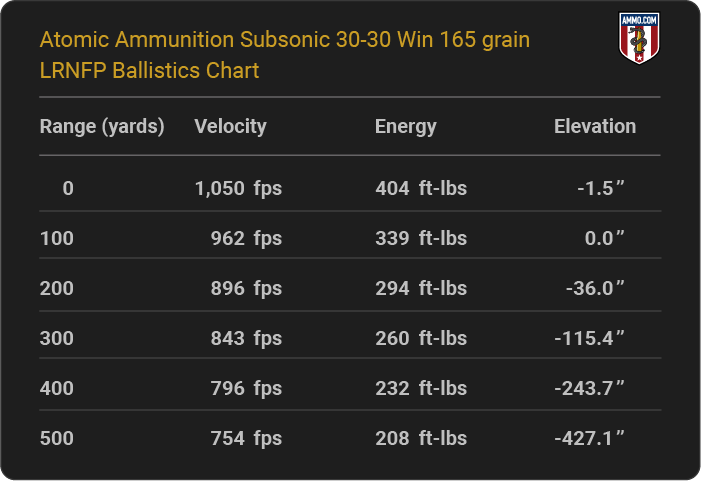
Barnes Ammunition Ballistics - 30-30 Winchester
Jump to a ballistics chart: Barnes Pioneer 30-30 Win 150 grain TSX FN | Barnes VOR-TX 30-30 Win 150 grain TSX FN FB | Barnes Pioneer 30-30 Win 190 grain Original
Barnes Pioneer 30-30 Win 150 grain TSX FN Ballistics Chart
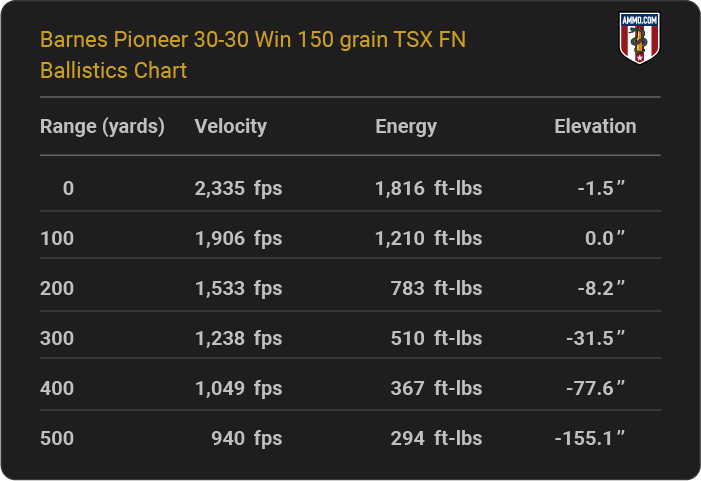
Barnes VOR-TX 30-30 Win 150 grain TSX FN FB Ballistics Chart
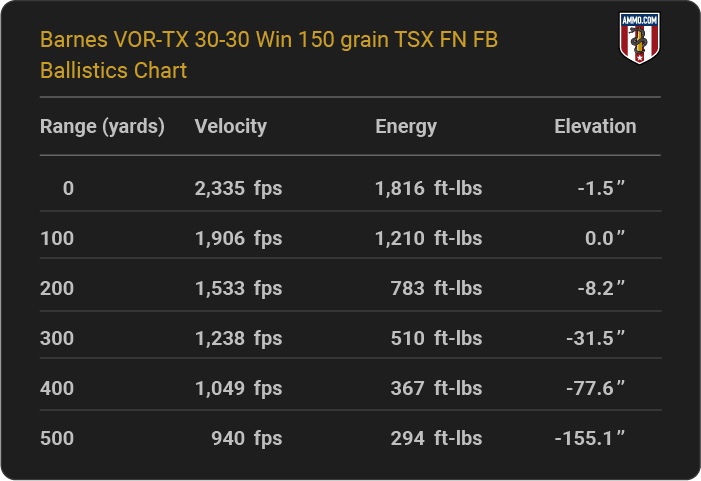
Barnes Pioneer 30-30 Win 190 grain Original Ballistics Chart
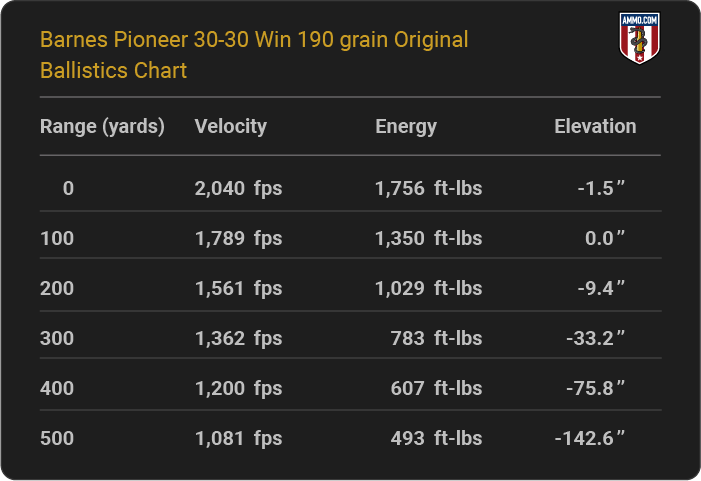
Browning Ammunition Ballistics - 30-30 Winchester
Jump to a ballistics chart: Browning MaxPoint 30-30 Win 150 grain Polymer Tip | Browning Silver 30-30 Win 170 grain PSP
Browning MaxPoint 30-30 Win 150 grain Polymer Tip Ballistics Chart
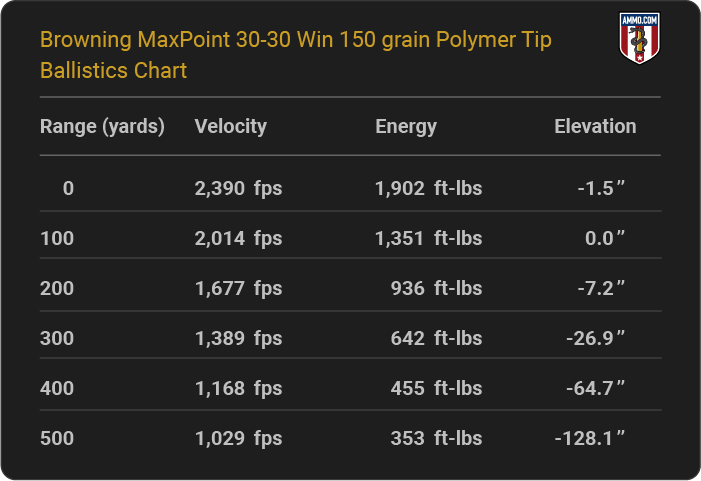
Browning Silver 30-30 Win 170 grain PSP Ballistics Chart

Buffalo Bore Ammunition Ballistics - 30-30 Winchester
Jump to a ballistics chart: Buffalo Bore Lead Free 30-30 Win 150 grain TSX | Buffalo Bore Heavy 30-30 Win 190 grain JFN
Buffalo Bore Lead Free 30-30 Win 150 grain TSX Ballistics Chart
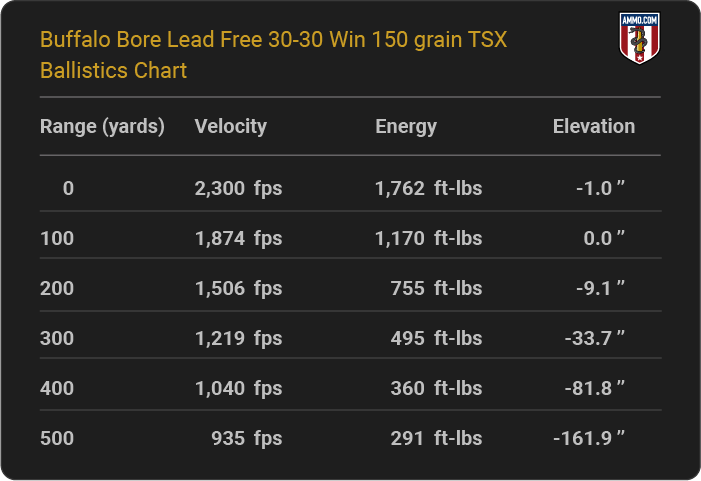
Buffalo Bore Heavy 30-30 Win 190 grain JFN Ballistics Chart
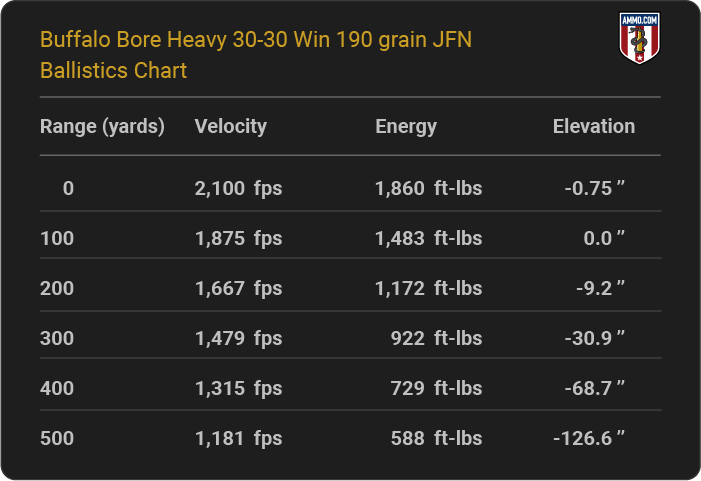
Federal Ammunition Ballistics - 30-30 Winchester
Jump to a ballistics chart: Federal HammerDown 30-30 Win 150 grain Bonded SP | Federal Premium 30-30 Win 150 grain TSX | Federal Premium 30-30 Win 150 grain Trophy Copper | Federal Fusion 30-30 Win 150 grain FSP | Federal Fusion 30-30 Win 170 grain FSP | Federal Power-Shok 30-30 Win 150 grain JSP | Federal Power-Shok 30-30 Win 170 grain JSP | Federal Premium 30-30 Win 170 grain Partition
Federal HammerDown 30-30 Win 150 grain Bonded SP Ballistics Chart
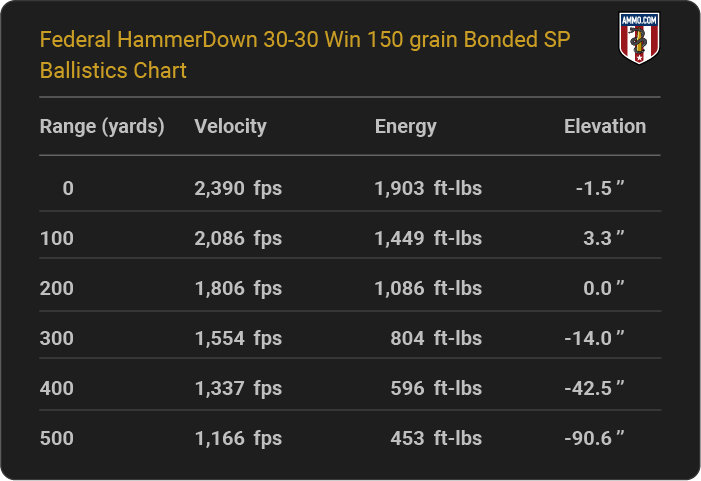
Federal Premium 30-30 Win 150 grain TSX Ballistics Chart
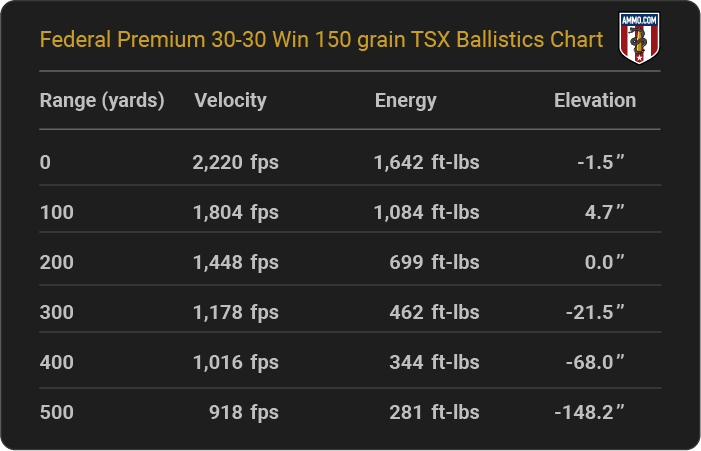
Federal Premium 30-30 Win 150 grain Trophy Copper Ballistics Chart
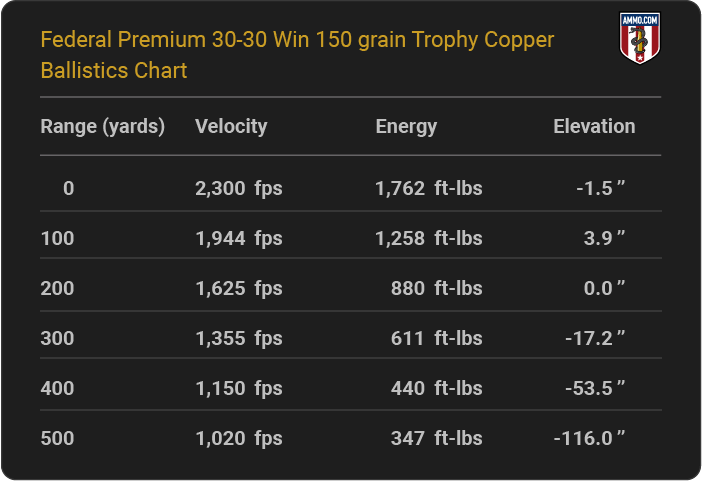
Federal Fusion 30-30 Win 150 grain FSP Ballistics Chart

Federal Fusion 30-30 Win 170 grain FSP Ballistics Chart
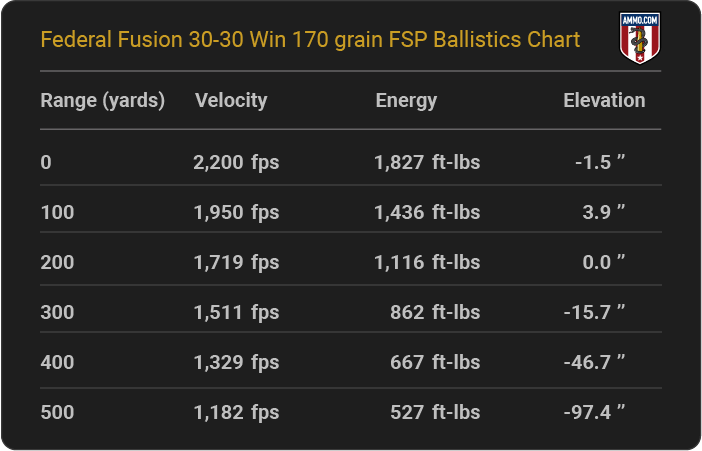
Federal Power-Shok 30-30 Win 150 grain JSP Ballistics Chart

Federal Power-Shok 30-30 Win 170 grain JSP Ballistics Chart
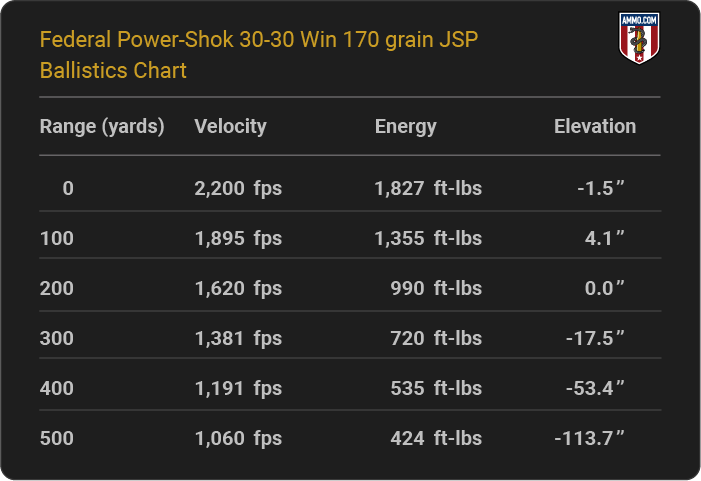
Federal Premium 30-30 Win 170 grain Partition Ballistics Chart
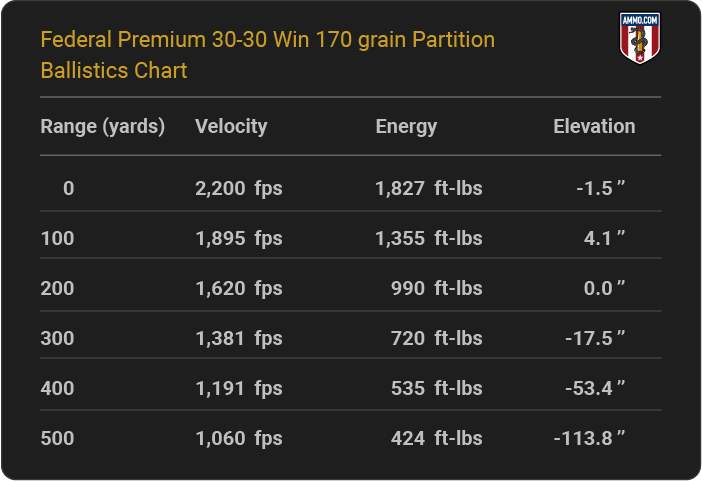
Fiocchi Ammunition Ballistics - 30-30 Winchester
Jump to a ballistics chart: Fiocchi Field Dynamics 30-30 Win 150 grain FSP | Fiocchi Field Dynamics 30-30 Win 170 grain FSP
Fiocchi Field Dynamics 30-30 Win 150 grain FSP Ballistics Chart
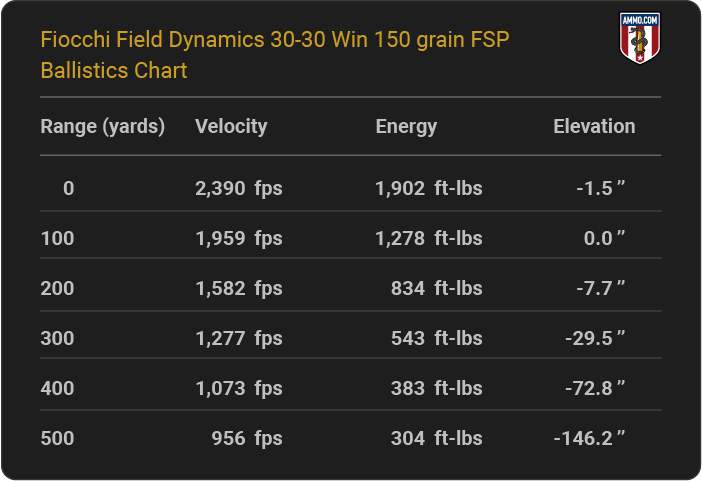
Fiocchi Field Dynamics 30-30 Win 170 grain FSP Ballistics Chart
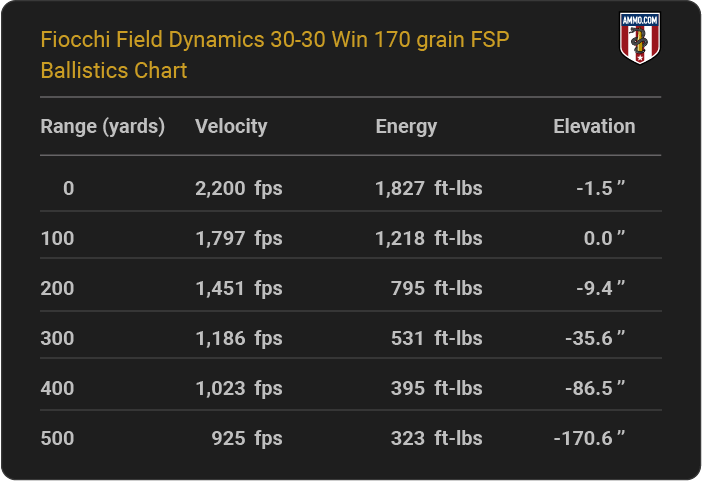
Fort Scott Munitions Ballistics - 30-30 Winchester
Fort Scott Munitions 30-30 Win 130 grain TUI Ballistics Chart

Freedom Munitions Ballistics - 30-30 Winchester
Freedom Munitions 30-30 Win 170 grain FP Ballistics Chart

Hornady Ammunition Ballistics - 30-30 Winchester
Jump to a ballistics chart: Hornady LeveRevolution 30-30 Win 140 grain MonoFlex | Hornady LeveRevolution 30-30 Win 160 grain FTX | Hornady American Whitetail 30-30 Win 150 grain RN InterLock | Hornady Subsonic 30-30 Win 175 grain Sub-X
Hornady LeveRevolution 30-30 Win 140 grain MonoFlex Ballistics Chart
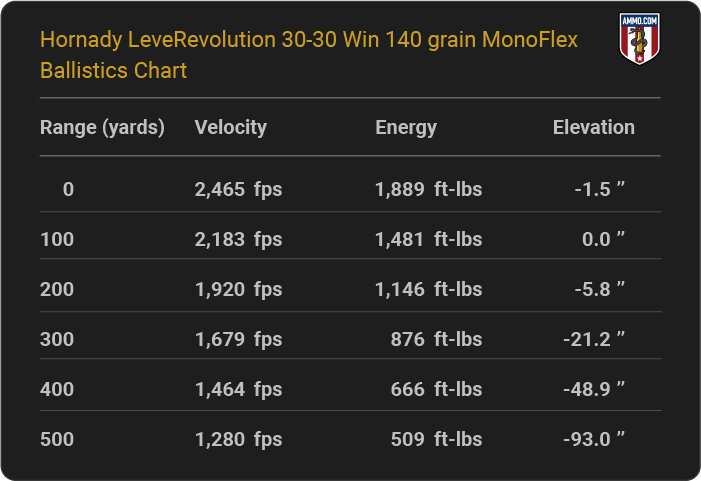
Hornady LeveRevolution 30-30 Win 160 grain FTX Ballistics Chart
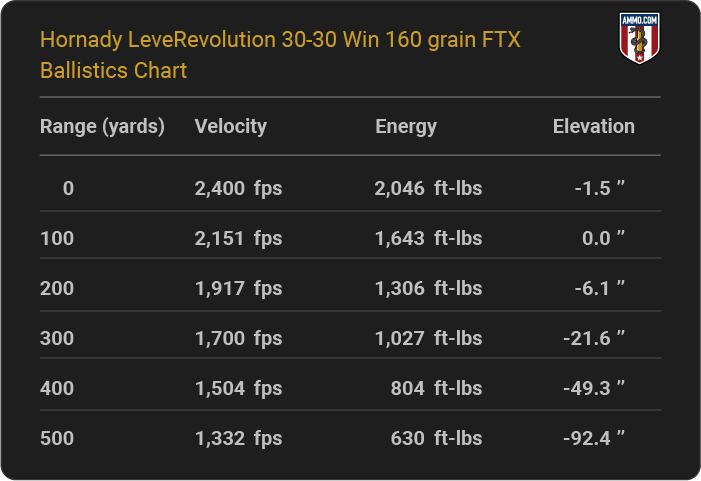
Hornady American Whitetail 30-30 Win 150 grain RN InterLock Ballistics Chart
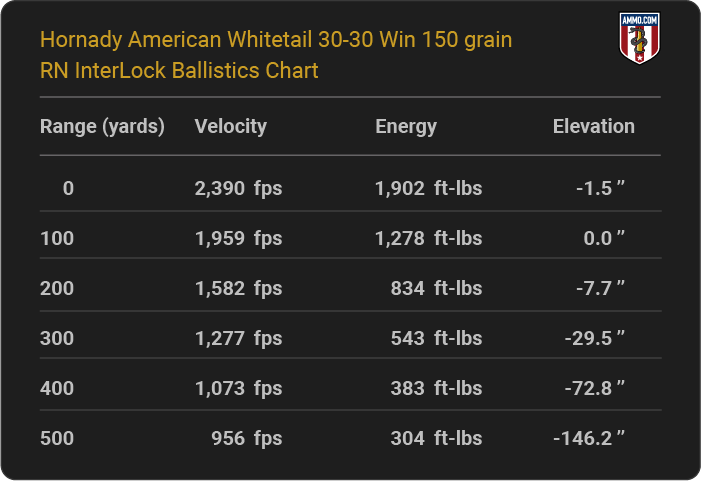
Hornady Subsonic 30-30 Win 175 grain Sub-X Ballistics Chart

HSM Ammunition Ballistics - 30-30 Winchester
Jump to a ballistics chart: HSM Lead Free 30-30 Win 150 grain TSX FN | HSM Cowboy Action 30-30 Win 165 grain Hard Cast RNFP
HSM Lead Free 30-30 Win 150 grain TSX FN Ballistics Chart
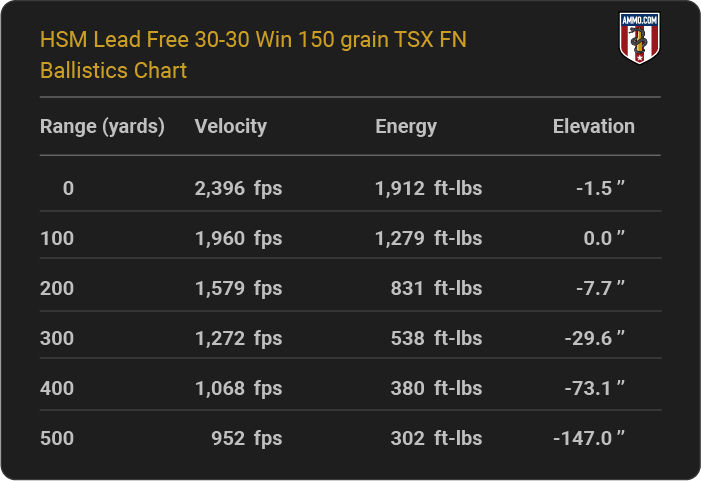
HSM Cowboy Action 30-30 Win 165 grain Hard Cast RNFP Ballistics Chart

Nosler Ammunition Ballistics - 30-30 Winchester
Jump to a ballistics chart: Nosler 30-30 Win 150 grain Ballistic Tip | Nosler 30-30 Win 150 grain Expansion Tip
Nosler 30-30 Win 150 grain Ballistic Tip Ballistics Chart
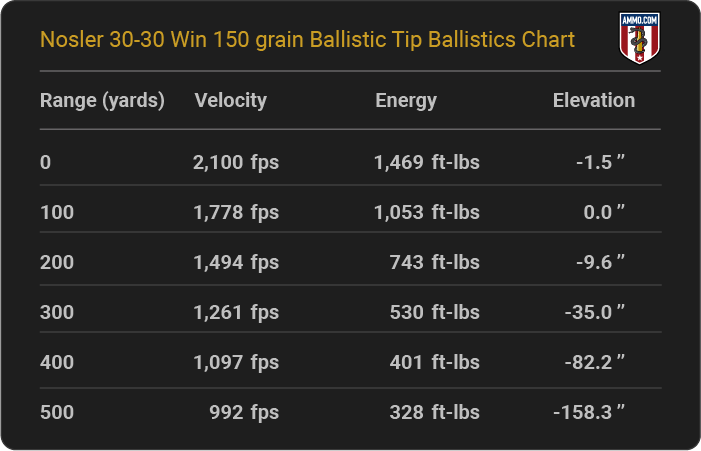
Nosler 30-30 Win 150 grain Expansion Tip Ballistics Chart
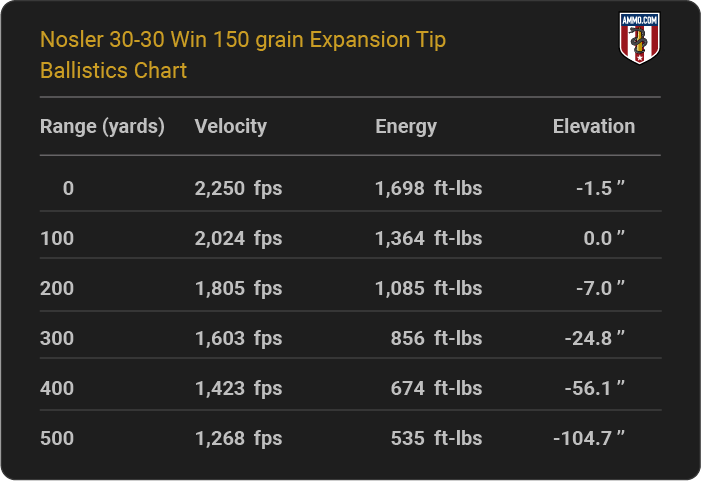
Prvi Partizan Ammunition Ballistics - 30-30 Winchester
Jump to a ballistics chart: Prvi Partizan 30-30 Winchester 150 grain FSP | Prvi Partizan 30-30 Winchester 170 grain FSP
Prvi Partizan 30-30 Winchester 150 grain FSP Ballistics Chart
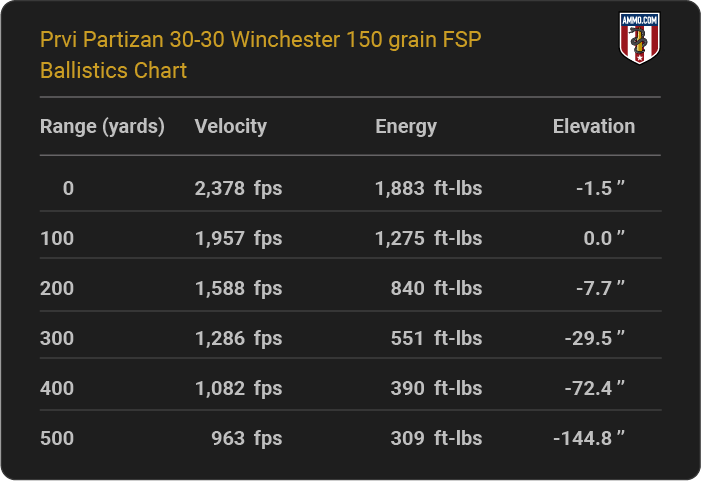
Prvi Partizan 30-30 Winchester 170 grain FSP Ballistics Chart
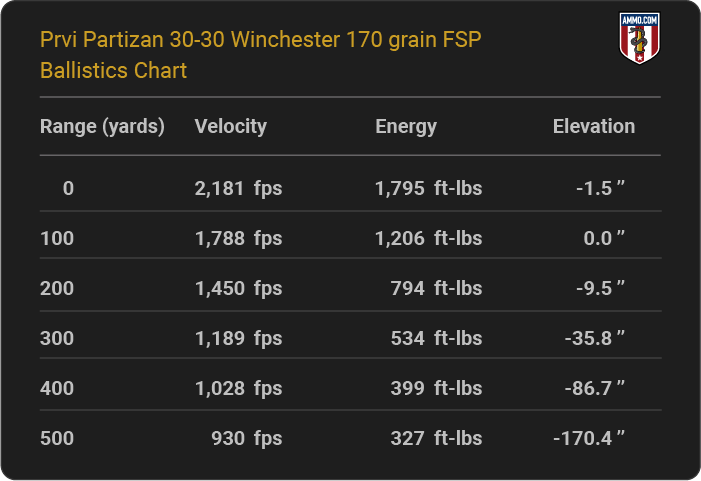
Remington Ammunition Ballistics - 30-30 Winchester
Jump to a ballistics chart: Remington Managed Recoil 30-30 Win 125 grain JSP | Remington Core-Lokt 30-30 Win 150 grain JSP | Remington Core-Lokt 30-30 Win 170 grain JSP
Remington Managed Recoil 30-30 Win 125 grain JSP Ballistics Chart
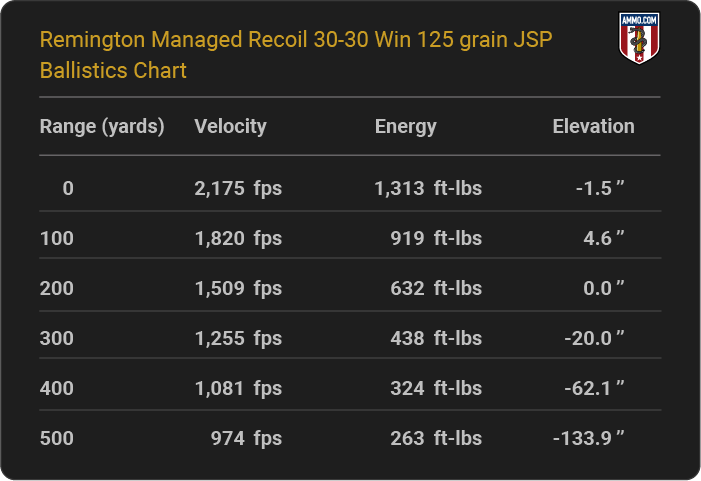
Remington Core-Lokt 30-30 Win 150 grain JSP Ballistics Chart
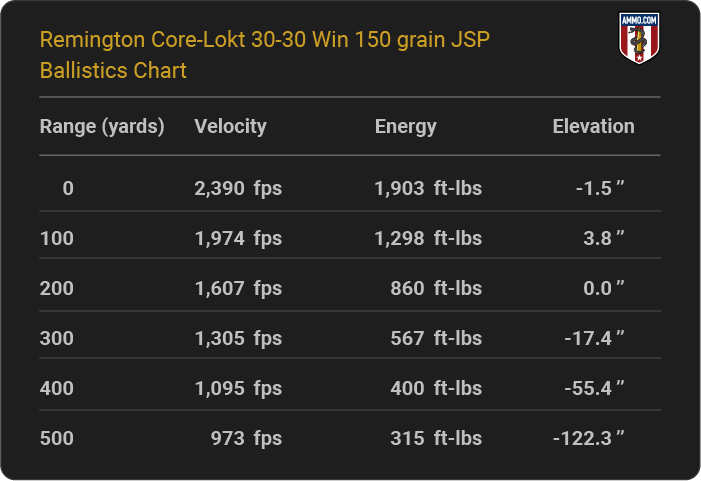
Remington Core-Lokt 30-30 Win 170 grain JSP Ballistics Chart

Sellier & Bellot Ammunition Ballistics - 30-30 Winchester
Sellier & Bellot 30-30 Win 150 grain JSP Ballistics Chart
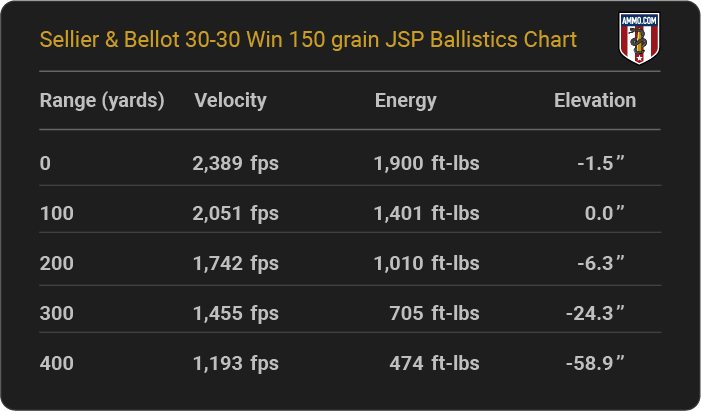
Underwood Ammunition Ballistics - 30-30 Winchester
Jump to a ballistics chart: Underwood Ammo 30-30 Win 140 grain Controlled Chaos | Underwood Ammo 30-30 Win 150 grain RN Ballistic Tip
Underwood Ammo 30-30 Win 140 grain Controlled Chaos Ballistics Chart
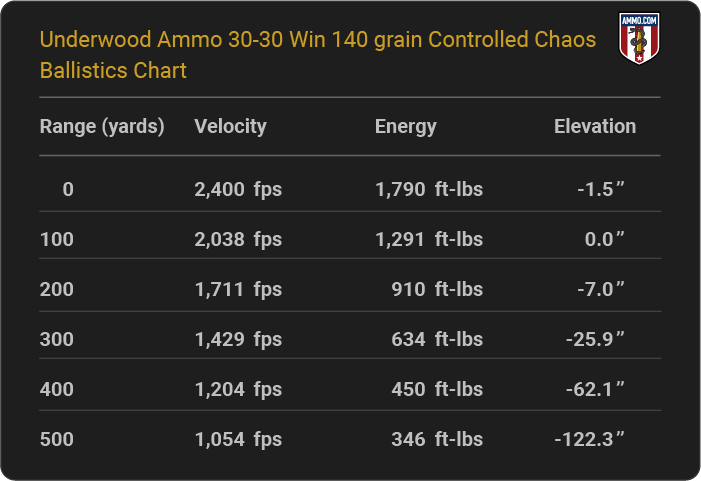
Underwood Ammo 30-30 Win 150 grain RN Ballistic Tip Ballistics Chart
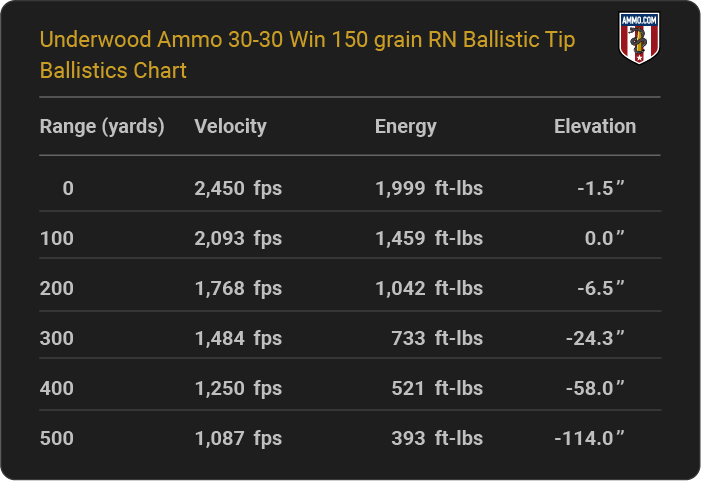
Winchester Ammunition Ballistics - 30-30 Winchester
Jump to a ballistics chart: Winchester Ballistic Silver Tip 30-30 Win 150 grain Polymer Tip | Winchester Deer Season XP 30-30 Win 150 grain Extreme Point | Winchester Super-X 30-30 Win 150 grain JHP | Winchester Super-X 30-30 Win 150 grain Power-Core | Winchester Power Point 30-30 Win 150 grain PP | Winchester Power Point 30-30 Win 170 grain PP
Winchester Ballistic Silver Tip 30-30 Win 150 grain Polymer Tip Ballistics Chart
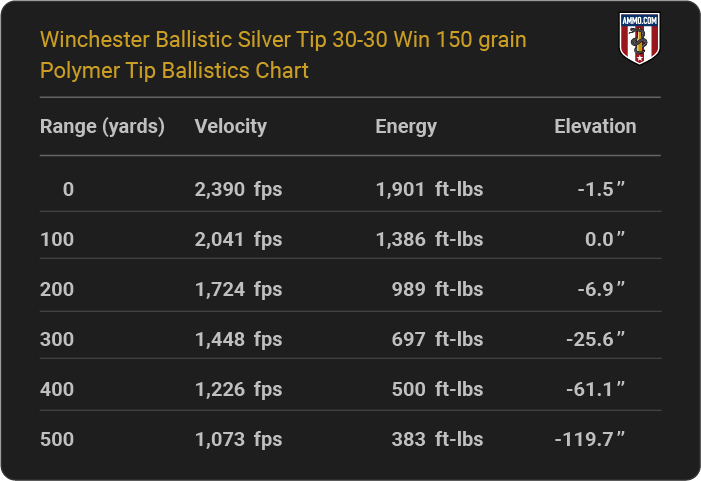
Winchester Deer Season XP 30-30 Win 150 grain Extreme Point Ballistics Chart
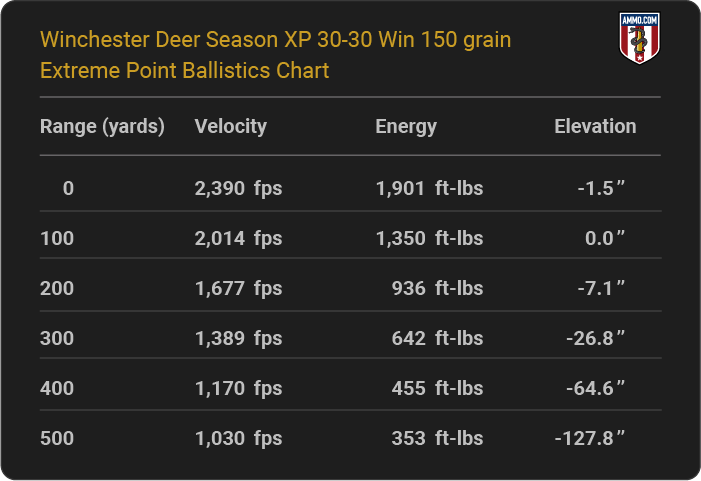
Winchester Super-X 30-30 Win 150 grain JHP Ballistics Chart
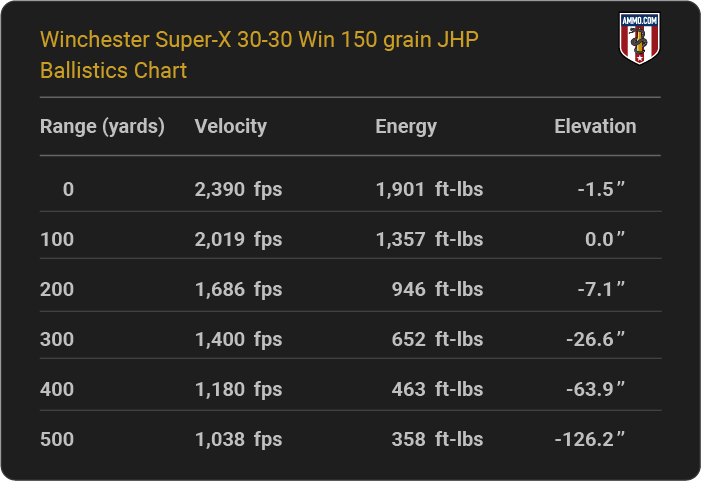
Winchester Super-X 30-30 Win 150 grain Power-Core Ballistics Chart
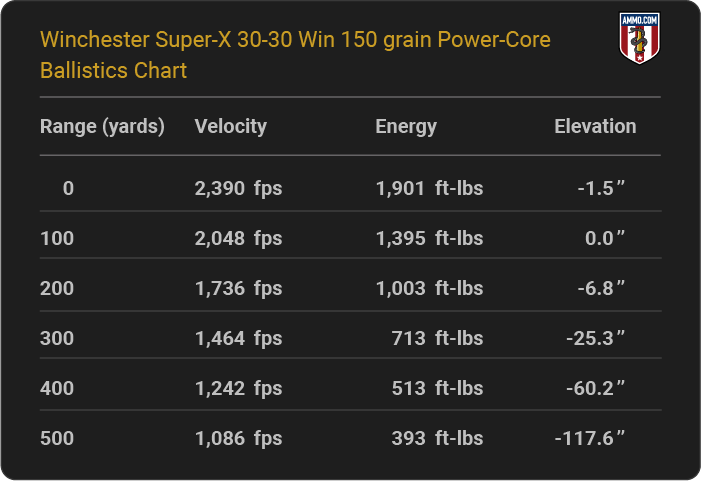
Winchester Power Point 30-30 Win 150 grain PP Ballistics Chart
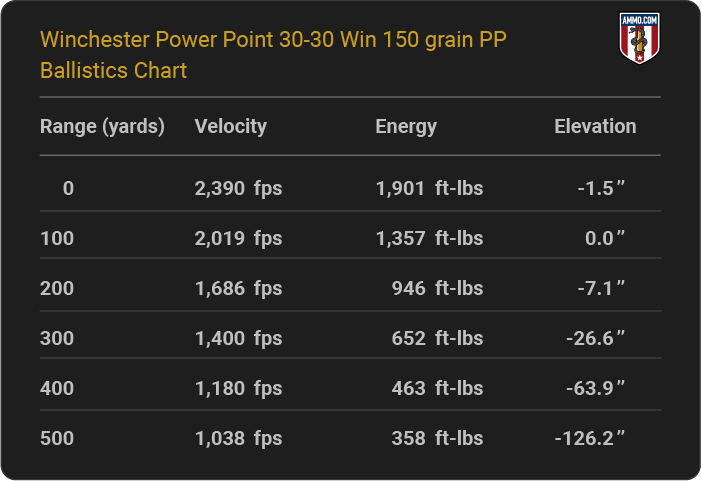
Winchester Power Point 30-30 Win 170 grain PP Ballistics Chart
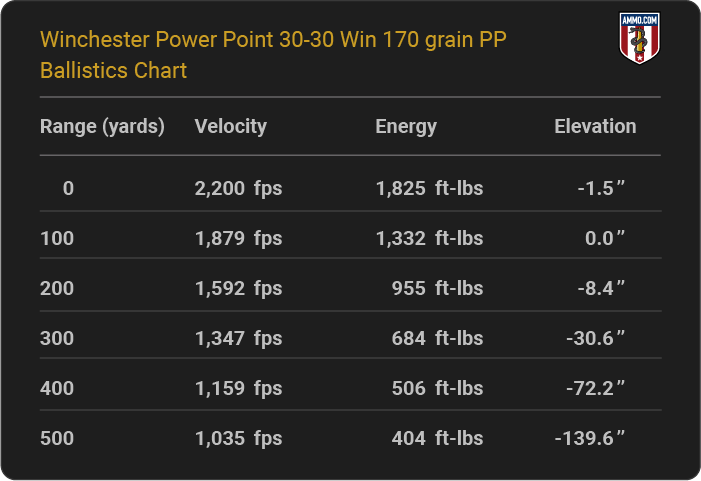
Note: This information comes from the manufacturer and is only informational. The actual ballistics obtained with your firearm can vary considerably from the advertised ballistics. Also, ballistics can vary from lot to lot with the same brand and type load.
30-30 Ballistics Trajectory Chart
30-30 Bullet Drop
A bullet’s flight path is also called its trajectory. Seasoned shooters measure the trajectory in inches of bullet drop.
A flatter trajectory is preferred for long-range shooting because the shooter will require fewer adjustments to compensate for bullet drop. The 6.5 Creedmoor is an excellent example of a flat trajectory.
However, as we can see, the 30-30 Win is not a long-range cartridge. It does not have a flat trajectory, thanks mostly to the flat-nosed bullets it is required to fire. These bullets do not slice through the wind very well, but they are needed to load safely into the tubular magazine of lever-action rifles.
When zeroed in at 100 yards, a 150 grain Winchester Power-Point bullet will drop 7 inches at 200 yards and 26.6 inches at 300 yards. By 500 yards, the 150gr bullet dropped 126.5 inches. Many American shooters use iron sights on their 30-30s because it’s incapable of making long-distance shots.
Below is a sample 30-30 bullet drop chart that gives you a general idea of the 30-30 Winchester trajectory.

Note: The chart above is an example of one 30-30 Winchester load, and actual ballistic performance may vary depending on bullet weight, lot, barrel length, and environmental conditions while shooting.
30-30 Muzzle Velocity (FPS)
Muzzle velocity is measured in feet per second (fps). It is the speed at which the bullet leaves the rifle barrel. Generally, a longer barrel length generates a higher muzzle velocity, allowing the powder to burn entirely and propel the bullet faster.
A Winchester 30-30 150-grain bullet will travel at 2,390 fps when it leaves the barrel. Underwood Ammunition increases the muzzle velocity of a 150gr RN ballistic tip to 2,450 fps. A Remington 170gr JSP has a muzzle velocity of 2,200 fps.
The problems lie in that the 30-30 cartridge is not powerful enough to maintain a high velocity for long, and the bullet has a low ballistic coefficient.
30-30 Effective Range
The effective range of a 30-30 is very limited due in part to the use of soft point, flat point, and round-nosed bullets used in the lever guns. Hitting a target at 500 yards will challenge most shooters with a 30-30 when target shooting.
300 yards is the general consensus for the effective range for ethically harvesting big game because the sectional density of 30-30 bullets is low. With this hunting rifle, you can get a little more distance when shooting varmints. However, shortly after 300 yards, the bullet slows down too much to be an effective hunting round, even with excellent shot placement on large game.
You must step up to a magnum load or choose a caliber available in bolt-action rifles to hunt big game past 300 yards, like the 6.8 Western, 300 Win Mag, or 30-06 Springfield.
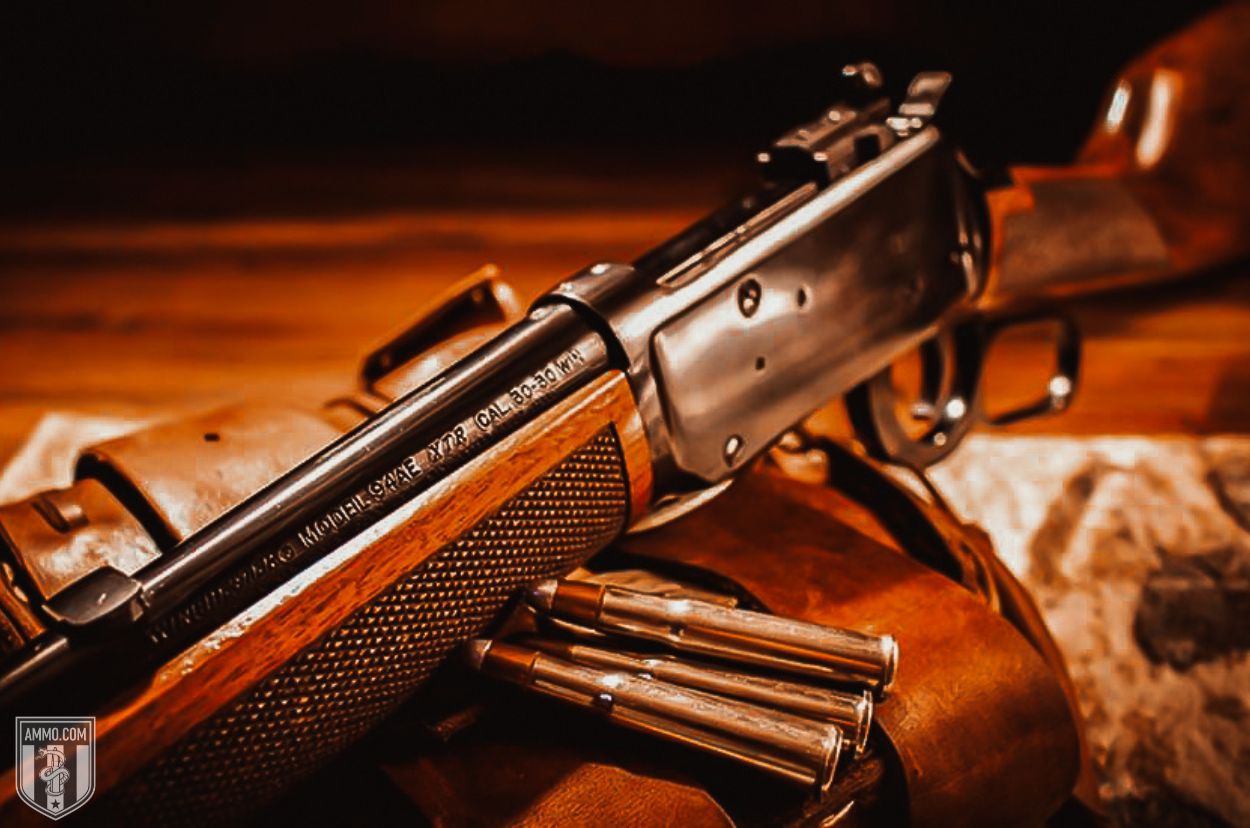
30-30 Energy Metrics
Muzzle energy is measured in foot-pounds (ft-lbs) of energy. It measures how much force a bullet delivers to its target.
The muzzle energy of Hornady LeveRevolution 30-30 Win 160 grain FTX is 2,046 ft-lbs, which is higher than other similar 30-30 ammo like the Browning MaxPoint 150 grain Polymer Tip that has a muzzle energy of 1,902 ft-lbs.
The Remington Core-Lokt 170gr JSP has a muzzle energy of 1,827 ft-lbs and 990 ft-lbs of energy at 200 yards.
How 30-30 Ballistics Compare to Other Rifle Cartridges?
We’ve seen how the 30-30 Winchester performs, but how does it measure up against similar calibers like the 30-06 and 30-378 Weatherby Magnum?
30-06 Vs. 30-30 Ballistics
Check out our article for an in-depth comparison of the 30-30 Win vs 30-06 Springfield.
The 30-06 and 30-30 shoot the same bullet weights, so we can do an apples-to-apples comparison. The main advantage the 30-30 has over the 30-06 is reduced recoil.
When shooting a 55 grain bullet, the 30-30 has a muzzle velocity of 3,400 fps while the 30-06 has a muzzle velocity of 4,080 fps shooting the same 55 grain bullet. When shooting a 170 grain bullet, the 30-30 Win has a muzzle velocity of 2,200 fps, yet the heavier 220 grain 30-06 Springfield bullet has a higher muzzle velocity of 2,410 fps.
The same pattern holds for muzzle energy. The 55 grain bullet of the 30-30 has 1,412 ft-lbs of energy, while the 30-06 has 2,033 ft-lbs of energy at the muzzle. When the 30-30 is loaded with a 125 grain bullet, it has comparable muzzle energy to the Hornady LeveRevolution 140 grain MonoFlex of 1,964 ft-lbs and 1,889 ft-lbs, respectively.
Even though the 30-06 isn’t known as a flat trajectory deer rifle, it still gives shooters less bullet drop than the 30-30.
30-378 Vs. 30-30 Ballistics
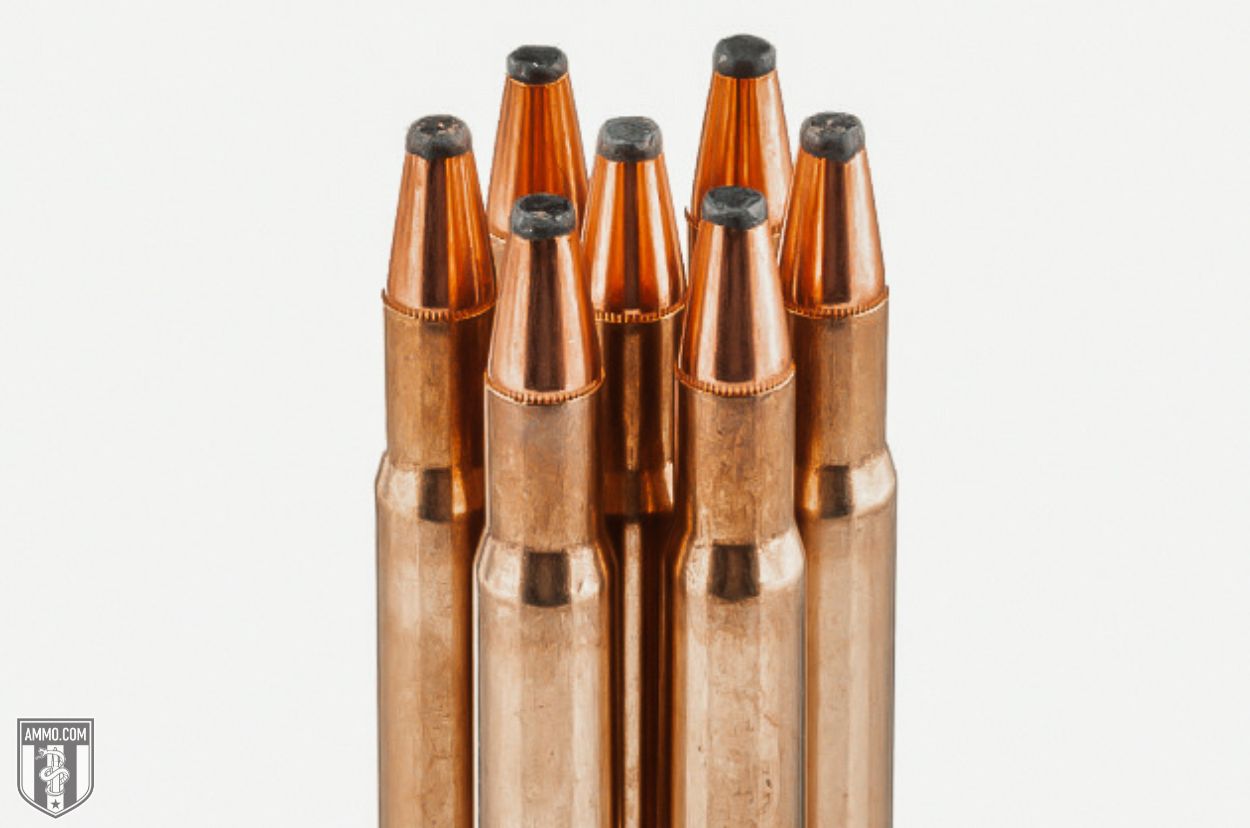
Another caliber we can compare the 30-30 to is the 30-378 Weatherby Magnum; however, you must keep in mind that a magnum cartridge is much more powerful than a non-magnum cartridge. So, the 30-30 doesn’t offer much ballistically, except for drastically reduced recoil.
The 30-378 will push a 220 grain bullet at 3,000 fps while the 30-30 struggles to push a 170 grain bullet over 2,200 fps.
The 220 gr bullet of the 30-378 also packs a punch with a muzzle energy of 4,695 ft-lbs, compared to the meager 2,046 ft-lbs of the 160 gr 30-30 FTX bullet, which has one of the highest muzzle energies of any 30-30 factory load.
As expected, the trajectory is no comparison. While the 30-30 tops out with a 300-yard effective range, while the 30-378 is just getting started. In fact, many 30-378 deer rifles are zeroed in at 300 yards because the trajectory is so flat.
Frequently Asked Questions
The team at Ammo.com has gathered and answered several of the most commonly asked questions regarding 30-30 ballistics.
What is the effective range of a 30-30 bullet?
200 yards is the maximum effective range of a 30-30 bullet.
How much does a 30-30 drop at 150 yards?
A 30-30 will drop about 5 inches at 150 yards when sighted in at 100 yards.
How much energy does a 30-30 have at 100 yards?
A 30-30 has about 1,300 ft-lbs of energy at 100 yards, depending on the bullet and load you shoot.
What is a 30-30 rifle good for?
A 30-30 rifle is good for whitetail deer hunting within 200 yards. Hogs, mule deer, pronghorn, and black bear have all also been harvested with a 30-30. Not to mention, a lever-action rifle is fun to shoot.
Ballistic Charts
- 308 Ballistics Charts
- 6mm ARC Ballistic Charts
- 10mm Auto Ballistics Charts
- 224 Valkyrie Ballistics Charts
- 204 Ruger Ballistics Charts
- 30-30 Ballistics Charts
- 6.8 SPC Ballistics Charts
- 350 Legend Ballistics Charts
- 300 Blackout Ballistics Charts
- FN 5.7x28 Ballistic Charts
- 7.62x39 Ballistics Charts
- 22 Creedmoor Ballistics Charts
- 300 PRC Ballistics Charts
- .360 Buckhammer Ballistics Charts
- 8.6 Blackout Ballistics Charts
- 30-06 Ballistics Charts
- 44 Magnum Ballistics Charts
- 7mm-08 Ballistics Charts
- 7mm Rem Mag Ballistics Charts
- 300 Win Mag Ballistics Charts
- 270 Win Ballistics Charts
- 45 Long Colt Ballistics Charts
- 6.5 Creedmoor Ballistics Charts
- 40 S&W Ballistics Charts
- 243 Win Ballistics Charts
- 357 Magnum Ballistics Charts
- 380 ACP Ballistics Charts
- 45 ACP Ballistics Charts
- 223 Rem Ballistics Charts
- 450 Bushmaster Ballistics Charts
- 400 Legend Ballistics Charts
- 5.56 Ballistics Charts
- 9mm Ballistics Charts
- 28 Nosler Ballistics Charts
- 45-70 Ballistics Charts
- 6.5 PRC Ballistics Charts
- 22-250 Ballistics Charts
- 22 Hornet Ballistics Charts
- 7mm PRC Ballistics Charts
- 22 ARC Ballistics Charts
- 6.8 Western Ballistics Charts
